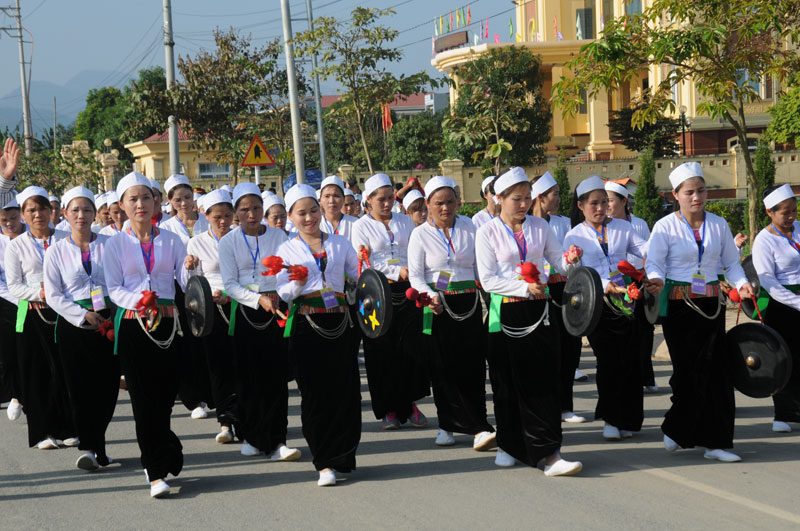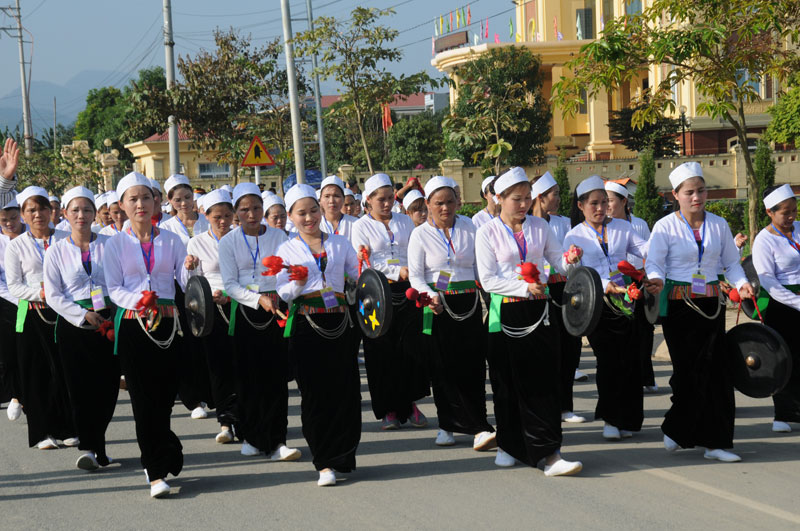



Muong women wear the traditional costumes.
The folklore researcher, Tu Chi once wrote: "They do not engrave on wood, on stone, on pottery, on metal, they do not sculpt wooden statues, stone statues, they do not shape statues from soil, they do not cast bronze statues but they weave the aesthetic concept on a women's waistband of the skirt! The skirt’s waistband here is like a statue or a picture!” It is indeed the most beautiful, the most quintessential and profound thing has been depicted on the traditional outfit of Muong ethnic women.
Currently, the traditional costumes are usually worn on holidays and New Year, while on the other normal days only mothers and grandmothers wear them. Meeting the needs of the wearers, today the traditional costumes of Muong ethnic women are modernly designed with eye-catching colors. The traditional costumes mainly have two main colors: brown and white.
The Pan blouses (short ones) have short-bodied wings reaching to the waist, the chest of the blouse is split and the sleeves are long. Inside, there is a type of Bang blouse (the overalls) with the top of the skirt emerging between two short pieces of the blouse. The highlight of the outfit is at the top and the waistband of the skirt. When being worn, an array of patterns emerges in the middle of the body. In particular, the skirt waistband shows the subtlety, the ingenuity and the depth in mind of the weaver. This part is usually made by three separate weaving parts and then interlocked together.
Together with a skirt is a pair of Tenh, usually made of linen blue or yellow cloth, which is longer than a span of the arm, stitched at both ends and tied right between the waist on the high skirt, making the wearer's waistline prominent. A set of silver chatelaine is hooked into one side from the hip wearing a hoop forward. The color of Muong women's outfit is not brilliant but elegant and profound, showing the personality of the Muong ethnic women - sincere, quiet and quite dedicated. The ancient traditional costume also clearly shows the status, the age, the class of women and Muong areas.
In particular, the headscarves are of important significance in the outfit of Muong ethnic women. It is white. Muong ethnic people perceive white as a purity, a nobility, a sky, a realm of ecstasy and profanity, so Muong ethnic women wear white headscarves to show respect and honor.
Besides the meaning of color, the sophistication, the originality and bold philosophy of the human life of Muong culture is also clearly shown in the way of wearing headscarf. The knot of the headscarf located at the top of the bun shows the peace. In addition, the outfit also has a long blouse (only worn during the festivals), a scarf to twist the blouse, a skirt’s waistband, a silver bracelet, a Cuom necklace bracelet, wrist bracelet…
Muong women wearing the traditional costumes in association with the gentle and graceful demeanor often feel more confident, softer and more flexible. Each detail on the outfit not only shows the cultural value but also shows the ingenuity of the girls. Muong girls wearing colorful outfits look like colorful flowers in the vast Northwest. And perhaps these things have made the Muong women in Hoa Bing always feel proud when wearing their own traditional costumes.